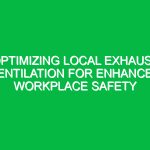In the world of health, safety, and environment (HSE) initiatives, the term PPE stands for Personal Protective Equipment. This essential gear plays a pivotal role in protecting workers from various hazards they may encounter in their roles. Whether it’s the construction site, a chemical plant, or a healthcare facility, PPE is designed to minimize exposure to risks that can lead to serious injuries or health issues. Understanding the significance of PPE and its application in the HSE domain is crucial for fostering a culture of safety and well-being in the workplace.
Understanding PPE and Its Relevance in HSE
PPE encompasses a wide array of equipment, including helmets, gloves, goggles, respirators, and protective clothing. The primary purpose of PPE is to create a barrier between an individual and potential hazards, thereby reducing the risk of injury or illness. For instance, in a manufacturing plant where workers are exposed to heavy machinery, wearing safety helmets and steel-toed boots can prevent head injuries and foot injuries from falling objects.
The relevance of PPE in HSE initiatives cannot be overstated. The Occupational Safety and Health Administration (OSHA) and other regulatory bodies emphasize the necessity of PPE to protect workers in industries ranging from construction to healthcare. This protective gear not only safeguards employees but also enhances productivity by reducing downtime due to injuries. In essence, PPE is a fundamental pillar of any effective HSE program.
Identifying Hazards and Risks Associated with PPE
Before we delve deeper into the safety precautions and best practices surrounding PPE, it is crucial to identify the potential hazards and risks that necessitate its use. Hazards can be classified into several categories, including physical, chemical, biological, and ergonomic risks.
Physical Hazards
Physical hazards are perhaps the most visible risks in many workplaces. These include falling objects, sharp edges, and exposure to extreme temperatures. In construction sites, for instance, workers face the risk of being struck by tools or materials. A personal anecdote comes to mind: a friend of mine, a construction worker, once recounted how a poorly secured tool fell from a height. Thankfully, he was wearing a hard hat, which prevented a potentially severe head injury.
Chemical Hazards
Chemical hazards are prevalent in industries that deal with toxic substances, such as pharmaceuticals or chemical manufacturing. Workers can be exposed to harmful chemicals through inhalation, skin contact, or ingestion. For example, in a laboratory setting, the lack of proper gloves and goggles can lead to serious chemical burns or respiratory issues.
Biological Hazards
In healthcare environments, biological hazards are a constant concern. Healthcare workers may encounter bloodborne pathogens, viruses, and bacteria. The COVID-19 pandemic highlighted the importance of PPE, such as masks and face shields, in protecting healthcare professionals from infectious diseases.
Ergonomic Risks
Ergonomic risks often go unnoticed but can lead to chronic injuries. Improper lifting techniques or prolonged awkward postures can result in musculoskeletal disorders. Although PPE alone cannot eliminate ergonomic risks, it can complement training and proper equipment to minimize injuries.
Safety Precautions and Best Practices Related to PPE
To maximize the effectiveness of PPE, it is essential to follow specific safety precautions and best practices. Here are some actionable tips that organizations and individuals should consider:
Conduct a Risk Assessment
Before selecting PPE, conduct a thorough risk assessment to identify the specific hazards present in the workplace. This assessment will guide you in choosing the appropriate protective gear. For instance, if employees are working with chemicals, ensure they are equipped with chemical-resistant gloves and goggles.
Train Employees on Proper Use
Training is a critical component of any PPE program. Employees must understand how to properly wear, maintain, and store their PPE. Regular training sessions can reinforce the importance of PPE and ensure that workers are familiar with its usage. For example, in a laboratory, staff should be trained on how to properly don and doff gloves and masks to prevent contamination.
Regular Inspection and Maintenance
PPE must be regularly inspected for wear and tear. Damaged equipment should be replaced immediately. For instance, a respirator with a worn-out filter will not provide adequate protection against airborne contaminants. Establishing a maintenance schedule can help ensure that PPE remains effective over time.
Promote a Culture of Safety
Encouraging a culture of safety within the organization is vital. Employees should feel empowered to speak up if they observe unsafe practices or if PPE is not being used properly. Leadership should model safe behaviors and recognize employees who prioritize safety.
Regulations and Standards Governing PPE
Various regulations and standards govern the use of PPE across different industries. In the United States, OSHA sets forth guidelines that employers must follow to ensure the safety of their workers. These regulations dictate the types of PPE required for specific jobs and outline the responsibilities of employers in providing this equipment.
In addition to OSHA standards, organizations can also refer to the National Institute for Occupational Safety and Health (NIOSH) for recommendations on PPE selection and use. Internationally, standards such as ISO 45001 provide frameworks for managing occupational health and safety, including the effective use of PPE.
The Future of PPE in Health, Safety, and Environment Initiatives
The landscape of PPE is continually evolving. Advances in technology are leading to the development of smarter, more effective protective gear. For instance, new materials can enhance breathability while maintaining protection. Wearable technology is also on the rise, with devices that monitor exposure to hazardous conditions in real-time.
As industries become more aware of the importance of health and safety, the demand for high-quality PPE will continue to grow. Companies that prioritize the well-being of their employees and invest in proper PPE will not only comply with regulations but also foster a more productive and motivated workforce.
Conclusion
PPE stands for Personal Protective Equipment, and it serves as an indispensable component of health, safety, and environment initiatives. By understanding the various hazards associated with different work environments and implementing effective safety precautions, organizations can significantly reduce the risk of injuries and illnesses among their employees. Regular training, maintenance, and adherence to regulations will further enhance the effectiveness of PPE in protecting workers. As we move forward, embracing advancements in technology will ensure that PPE continues to evolve, providing even greater safety for our workforce.


